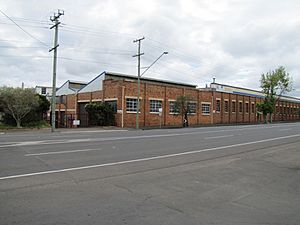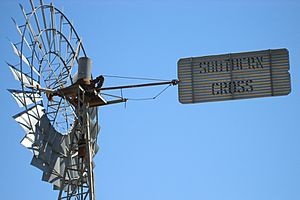Toowoomba Foundry facts for kids
Quick facts for kids Toowoomba Foundry Pty Ltd |
|
|---|---|

Toowoomba Foundry, 2012
|
|
| Location | 251-267 Ruthven Street, Toowoomba, Queensland, Australia |
| Design period | 1870s - 1890s (late 19th century) |
| Built | c. 1910 - 1940s |
| Official name: Toowoomba Foundry Pty Ltd, Griffiths Brothers and Company, Southern Cross Works, Toowoomba Foundry and Railway Rolling Stock Manufacturing Company | |
| Type | state heritage (built) |
| Designated | 7 July 2004 |
| Reference no. | 601300 |
| Significant period | c. 1910-1940s (fabric) 1876-1987 (historical) |
| Significant components | railway, machinery/plant/equipment - manufacturing/processing, canteen, workshop, trees/plantings, office/administration building |
| Lua error in Module:Location_map at line 420: attempt to index field 'wikibase' (a nil value). | |
The Toowoomba Foundry Pty Ltd was a very old factory in Toowoomba, Queensland, Australia. It was a "foundry," which is a place where metal is melted and poured into molds to make different shapes and products.
This important site was built between about 1910 and the 1940s. It was also known by other names like Griffiths Brothers & Company and Southern Cross Works. The foundry was added to the Queensland Heritage Register in 2004 because of its history.
Part of the old foundry site has been redeveloped. A new Bunnings Warehouse store was built there. This new store opened in late 2017.
Contents
A Look Back: The Foundry's History
The Toowoomba Foundry is located on Ruthven Street. It's right next to the Defiance Flour Mill and the Toowoomba railway station. George Washington Griffiths started the foundry in 1871. It kept making metal products until 2012.
The Griffiths family owned the foundry until 1987. Then, a company called National Consolidated bought it. This foundry is one of the last old factories from the 1800s in the Darling Downs area.
Early Days of Toowoomba
The area where Toowoomba is now was once called "The Swamp." In the 1840s, a nearby town called Drayton was more important.
Europeans first explored the Darling Downs in 1828. A route was found through the Great Dividing Range. This route connected the Darling Downs to the Moreton Bay region.
In 1840, Patrick Leslie was the first European settler in the Darling Downs. More settlers soon followed. By 1848, people moved to "The Swamp" because Drayton had water shortages. "The Swamp" was renamed Toowoomba in 1858.
How the Foundry Started
George Washington Griffiths came to Australia from England in 1870. He settled in Toowoomba and worked as a builder.
In 1871, his father sent him some iron goods. This helped George start a shop and a small repair foundry. He worked with his brother-in-law, William Atherton.
In 1873, Atherton left the business. George's brother, John, who was an engineer, joined him. Their small workshop quickly grew bigger.
A New Location and Growth
In 1874, George sold the shop part of the business. He bought land on Campbell and Ruthven Streets. He wanted to focus only on engineering.
The new factory, called Griffiths Brothers and Company, opened in 1876. It had an office, a storeroom, and four workshops. These workshops included areas for sawing, fitting, casting metal, and blacksmith work. The first iron casting in the Darling Downs happened here.
John Griffiths left the business that same year. He became an engineer for Queensland Railways. However, he still had a financial interest in the foundry.
Making Windmills and Railway Parts
The foundry had some tough times at first. But by 1881, things got better. They were making many things, including steam engines, wool presses, and pumps. They also made windmills and parts for the Queensland Government Railways.
In 1883, George Griffiths bought out his partners. He formed a public company in 1884. It was called the Toowoomba Foundry and Railway Rolling Stock Manufacturing Company Ltd. George was the managing director. Even though it was a public company, the Griffiths family bought enough shares to stay in control.
By 1886, the foundry had 72 workers. They had a showroom and several workshops. They were especially proud of their windmills.
Surviving Tough Times
The foundry did well until the early 1890s. Then, an economic downturn made business slow. But the Toowoomba Foundry was strong enough to buy out a rival company, Reliance Foundry.
The foundry survived these hard times by making "Simplex windmills." These windmills were very important for farmers in the Darling Downs. They helped farmers get water from underground. Hundreds of these windmills were sold.
Business picked up again in the late 1890s. The foundry got new contracts to build railway parts. Between 1909 and 1910, they built many engines for Queensland Railways. They also built more locomotives in 1912-1913 and 1914-1915. One of these old locomotives is now in the Queensland Rail Museum.
In 1903, the "Southern Cross windmill" was designed. This was a big success for the company. They started using "Southern Cross" as their main brand name.
George W. Griffiths passed away in 1924. His sons, Alfred and George, continued to run the business. The company grew and sold products in the Middle East and South Africa.
World War II and Beyond
During World War II, the foundry expanded even more. Over 1000 people worked there. They made engines and pumping units for the Australian Government and the armies of Britain and the United States.
After the war, the company kept growing. They had many sales offices overseas and in different parts of Australia. They even had an export division by 1945.
The Griffiths family owned the company until 1987. Then, National Consolidated bought it. Over the years, the foundry site became smaller. Some buildings were sold to the Defiance Flour Mill. The northern part of the site is now owned by Southern Cross, which is a separate company.
In 2002, Southern Cross Windmills moved to a new location near Toowoomba.
Most of the buildings at the old foundry site are from the late 1800s or early 1900s. They were changed and added to in the 1920s and 1940s.
The site kept working as a foundry until it closed in mid-2012. In 2013, Bunnings Warehouse bought the site. They planned to build a new store there. In 2015, the Toowoomba Regional Council approved the demolition of some of the old buildings. However, Bunnings kept some important heritage buildings, like the old canteen. Construction for the new store began in 2016.
What the Foundry Looked Like
The Toowoomba Foundry site is on Ruthven Street. It's next to the Defiance Flour Mill and the Toowoomba Railway Station. It's a very noticeable part of the industrial area on Ruthven Street. You can see it clearly from both the east and west sides. There are some old trees and new plants in front of the building on Ruthven Street.
The main entrance is on Ruthven Street. Along this street, there is a long, single-story brick building. This building has many sections, each with a window. There is also a door in one section. The top of this building has a concrete wall with the Toowoomba Foundry logo painted on it.
At the southern end, there's another part of the building made of similar bricks. At the northern end, the building forms a "U" shape around a car park.
Inside, these buildings had a reception area, offices, and a canteen. Many parts of the inside have been changed over the years. So, not much of the original inside is left.
The rest of the site had workshops for machines, molding, and cores. These buildings were made with steel frames and covered with corrugated iron. Some still have parts of old industrial machines, like cranes.
The areas between the buildings are now paved. You can still see parts of old railway tracks in the south-western corner of the site.
Why It's a Heritage Site
The Toowoomba Foundry Pty Ltd was added to the Queensland Heritage Register in 2004. This means it's an important historical place. Here's why:
- Shows Queensland's History: The foundry started in 1871 and operated for a very long time. It shows how important factories were to Queensland's economy and society. It also shows how important railways were for developing industries in the 1800s.
- Uncommon and Special: It's rare to find an industrial site in Queensland that was used continuously for almost 130 years. It also stayed in the same family for over 110 years.
- Shows How Factories Change: The foundry operated for nearly 130 years. It shows how an industrial site changes over time. It grew and developed based on what people needed, like railway parts, windmills, and engines during World War II. You can see this history in the different ages and styles of buildings on the site.
- Looks Important: The foundry is a key part of the industrial look of Ruthven Street. It stands out in the wider industrial area, especially from the Toowoomba Railway Station. The large, corrugated iron buildings look very industrial. The brick office building on Ruthven Street looks more formal.
- Important to the Community: The Toowoomba Foundry was a major employer in Toowoomba for a long time. It has a strong connection to the people who worked there and to the local community. The canteen built during World War II was especially important for workers. The foundry is also strongly linked to rural Australia because it made so many famous windmills.
Engineering Award
The Southern Cross windmill, which was made at this foundry, received a Historic Engineering Marker. This award is from Engineers Australia. It recognizes important engineering achievements.


